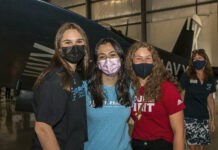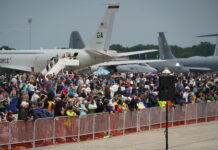Recently, my wife and I rented the movie Bottle Shock. Based in the mid-1970s, the film recounts how the vintners of Napa Valley established the reputation of their wines in a blind taste test against their French competitors. At several junctures in the movie, recognizing that anything that brought positive attention to one of their wines would reflect well on all of their wines, the Californians observed, “If one of us wins, we all win.”
Our business faces a similar situation as it relates to the visibility that we give to our civilian performers.
Back here at ICAS headquarters, members often call after a show to share their perspectives on what went well and what went poorly. A particular theme developed early this season and gained momentum as the season progressed. There is an expectation within our business – among both organizers and performers — that the air show community should be doing more to turn our pilots into stars.
Over the years, we have done a good job at doing this for the military. The teams are featured on posters, souvenir programs, and television advertisements. The Thunderbirds, Blue Angels, and Snowbirds are now the closest thing we have to household names in our industry.
But past efforts to showcase our civilian performers have run into a “chicken vs. egg” debate that is nearly as old as the air show industry itself. Are our performers less well known because we don’t promote them? Or do we fail to promote them because they are not as popular with spectators as the jet teams and military performers? But perhaps the more pertinent question is, “Doesn’t it help our entire industry if we all work harder to showcase both our military AND civilian performers as the extraordinarily talented aviators and entertainers that they all are?
Take, as an example, the autograph tent. Some organizers consider the whole notion to be a waste of time. And there are performers who are uncomfortable with the idea of signing autographs and mingling with air show fans. But the more progressive show directors and pilots recognize that the autograph tent isn’t an annoyance; it’s a unique opportunity to turn spectators into fans, to help our performers make personal connections with the public.
Similarly, only a few shows position the civilian performers’ aircraft in a location where the public can see these vintage warbirds and state-of-the-art aerobatic aircraft, and talk with the pilots about their planes. The Red Bull Air Races can teach us some valuable lessons here. Red Bull sells tickets for fans to come to the hangar area to see the planes parked in the hangar and chat with the pilots and crew chiefs. It’s a logistical challenge that requires additional time and resources, but it has been an important tool in helping to introduce the pilots to the public and establish the new sport of Red Bull air racing.
Increasingly, event organizers are basing their hiring decisions on the whole package that a performer offers. As an example, professional-looking flight suits that were a rare sight a few years ago are becoming much more common. It’s no longer enough for a pilot to say, “My flying says everything you need to know about me.” Pilots are expected to be more than pilots; they’re expected to be entertainers and look the part, both in the air AND on the ground.
Forward-thinking organizers and pilots also see an opportunity at social functions. Typically, show management uses these events to introduce the jet team or single ship demo team. And they deserve that recognition. But leaving the civilian performers in their seats is both a missed opportunity and a clear message to the sponsors, elected officials, media and assorted mucky-mucks that gather for these events: the military are the main attractions and the civilians are filler. Some shows are now finding, it makes more sense to showcase all of the performers, and recognize each of them for the unique contributions they make to the show.
Our more progressive organizers and performers argue that we should do all of these things not because the performers are attention-starved narcissists who can never get enough attention, but because if one of us wins, we all win. At the most obvious level, these kinds of initiatives help position the civilian pilots as the remarkable, talented performers that they are. But that’s just the beginning. Better visibility and more exposure for our civilian pilots help deepen the interest and increase the loyalty of our fans. It’s not just the performer who benefits, it’s the show, too. And the entire industry.
If the calls and e-mails we have received this summer are any indication, we may be at a bit of a tipping point on this issue. Clearly, fortunes will not be made or lost based on whether or not Tommy Lomcevak wears a flight suit, gets introduced at the spaghetti dinner or spends 45 minutes in the autograph tent. But, at least from my seat, expectations are changing and the paradigm seems to be shifting. Will you shift with it or stand by and watch as change happens without you?








